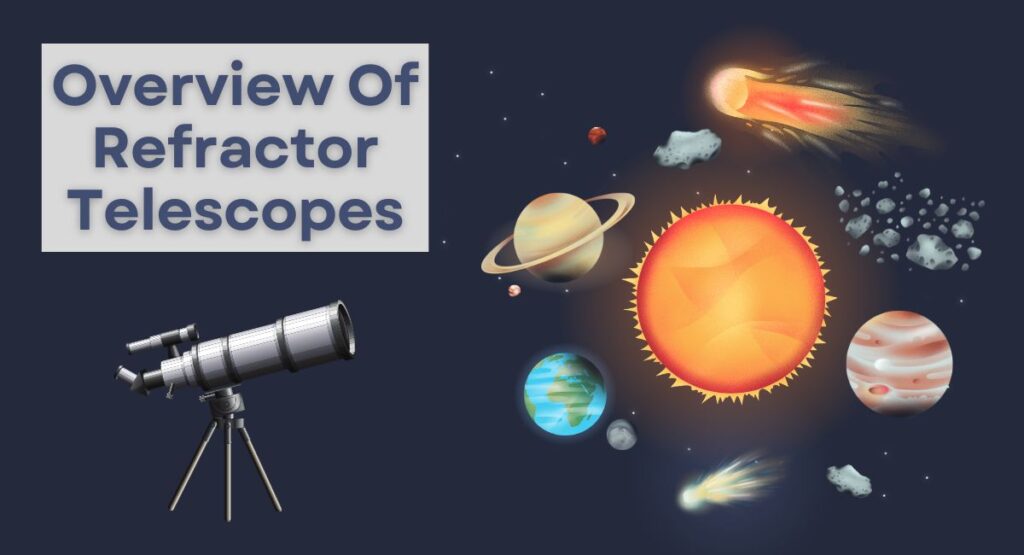Refractor telescopes, often referred to as refractors, have played a pivotal role in our exploration of the cosmos. Dating back to the early days of astronomy, these telescopes have evolved significantly in terms of design and technology. In this blog post, we will delve into the technical aspects of refractor telescopes, highlighting their key features and providing examples of their applications, all while unraveling the mysteries of the universe.
You May Like : Skywatcher’s Guide : Details Of Telescope, Type and Components and Telescope Price
Table of Contents
Optical Design
Objective Lens : At the core of every refractor telescope lies its objective lens, typically crafted from high-quality glass. This lens acts as the primary light-gathering and focusing element.
Aperture Size : The diameter of the objective lens determines the telescope’s aperture size, a critical factor influencing the amount of light collected. Larger apertures result in clearer and brighter images, making them ideal for deep-sky observations.
Types of Refractor Telescopes
Apochromatic Refractors : These telescopes utilize multiple lenses to correct for chromatic aberration, producing high-contrast and color-accurate images. The Explore Scientific ED127 Essential Series is a prime example of a reliable apochromatic refractor.
Achromatic Refractors : More budget-friendly, achromatic refractors may exhibit chromatic aberration, causing color fringing around bright objects. The SkyWatcher Evostar 90 is a popular choice among beginners.
Focal Length and Magnification
Focal Length : The distance from the objective lens to the point where the image comes into focus is the focal length. Longer focal lengths provide higher magnification, making them suitable for planetary and lunar observations.
Eyepiece Selection : Astronomers can manipulate magnification by using different eyepieces. For example, combining a 25mm eyepiece with a telescope with a 1000mm focal length results in 40x magnification, suitable for wide-field observations.
Mounting Systems
Equatorial Mounts : For precise tracking of celestial objects, refractors can be mounted on equatorial mounts. These mounts compensate for the Earth’s rotation, allowing the telescope to follow the motion of the stars. The Celestron Advanced VX 6 Refractor Telescope is a reliable choice for equatorial tracking.
Alt-Azimuth Mounts : Simpler and more intuitive, alt-azimuth mounts move the telescope up and down (altitude) and left and right (azimuth). The Celestron – StarSense Explorer LT 80AZ is a user-friendly alt-azimuth refractor.
Applications and Examples
Planetary Observation : Refractors excel in observing planets, providing sharp and detailed images of their surfaces and atmospheric features. The Celestron NexStar 4SE refractor is renowned for its planetary capabilities, delivering crisp views of Jupiter’s bands and Saturn’s rings.
Lunar Observation : The Moon’s crisp details are beautifully captured by refractors. The SkyWatcher Evostar 120 is a popular choice for lunar enthusiasts, revealing intricate features such as lunar craters and mountain ranges.
Deep-Sky Objects : While not as common as reflectors for deep-sky observations, some refractors like the Explore Scientific ED102CF can deliver stunning views of galaxies, nebulae, and star clusters, providing a unique perspective on the vastness of our universe.
Maintenance and Care
Cleaning : Regularly cleaning the objective lens is crucial for maintaining image clarity. Special care should be taken to avoid scratches and dust particles, as they can significantly impact the quality of observations.
Storage: Proper storage in a protective case or cover is essential to prevent damage to the lens and telescope structure. Refractors are precision instruments, and careful handling ensures their longevity.
Challenges and Considerations:
Chromatic Aberration : Achromatic refractors may exhibit color fringing, especially at higher magnifications. Apochromatic refractors address this issue but come at a higher cost. Choosing the right balance between budget and optical performance is crucial for potential buyers.
Weight and Portability : Large refractors can be heavy and less portable than smaller models, impacting their ease of use for certain observers. Considerations such as transportation and setup should be taken into account when selecting a refractor telescope.
Conclusion
In conclusion, refractor telescopes stand as a testament to humanity’s curiosity about the cosmos. Their optical precision, combined with advancements in design and technology, make them versatile instruments for exploring the wonders of the night sky. Whether observing planets, the Moon, or deep-sky objects, a well-maintained refractor telescope can provide breathtaking views that inspire and ignite the curiosity of sky gazers worldwide. As we continue to peer through these lenses, we unlock the mysteries of the universe, one refracted beam of light at a time.
You May Like : Skywatcher’s Guide : Details Of Telescope, Type and Components and Telescope Price

